Rosa Parks, the Montgomery Bus Boycott and the media helped change Jim Crow laws and opened film roles for today's young black Hollywood actors.
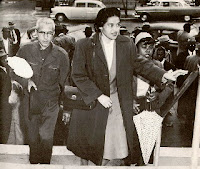 |
| Rosa Parks (1913-2005) Going to Court after Arrest The Montgomery Bus Boycott |
Before Rosa Parks sparked the Montgomery Bus Boycott in 1955, U.S. race relations retained subservient roles for black Americans and spilled the practice into all aspects of Jim Crow life, ranging from the Jim Crow Hollywood film industry to the back seats on Jim Crow buses.
After Rosa Parks, however, Jim Crow Hollywood and Jim Crow America were forced to change their portrayal and treatment of African Americans in film and in real life.
After Rosa Parks, however, Jim Crow Hollywood and Jim Crow America were forced to change their portrayal and treatment of African Americans in film and in real life.
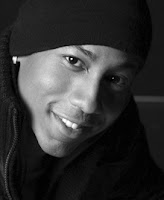 |
| Brandon T. Jackson Filmography |
Looking at the history of Jim Crow Hollywood, one sees that Rosa Parks, Montgomery Bus Boycott, Dr. Martin Luther King, Jr., Woolworth Sit-ins, Lena Horne, Sidney Poitier and many paved the path for today's young black Hollywood stars--Zoe Kravitz; Evan Ross, son of entertainer, Diana Ross; Keke Palmer; or Brandon T. Jackson--all among today's hottest young black Hollywood stars, according to Next Movie. Because of civil rights activists, events, protests, lynching and other related violence of the Jim Crow past, America has a young black Hollywood community that may look physically similar to the young black Hollywood community of past decades.
The difference between the present black Hollywood and the black Hollywood of the past lies in the roles today's young black Hollywood actors are allowed to play on screen, behind the cameras and in executive positions. Some young black stars are not only starring in major motion pictures, but they are also participating in the creation, financing, distribution and promotion of their projects.
 |
| Zoe Kravitz |
Zoe Kravitz, who emerges from a Hollywood heritage, is third generation black Hollywood. Her father is singer-songwriter-actor Lenny Kravitz; her mother is actor, Liza Bonet; her grandmother was actor Roxie Roker; and her cousin is NBC's Al Roker. Although Zoe Kravitz is mixed racial heritage and identifies herself also as a secular Jew, in the Jim Crow Hollywood film industry of the past, she would have been cast in the same manner as mixed-race actor, Lena Horne, and other black actors of the time.
Also on the 20-something-year-old and younger Next Movie Hollywood's 9 Hottest Young Black Stars list are: Gabourey Sidibe; Donald Glover; Jaden Smith, son of actors, Will Smith and Jada Pinkett Smith; Tessa Thompson, Katerina Graham and Kali Hawk with a lot of film real estate between their careers and Jim Crow Hollywood history preceding them.
Before many of the young black Hollywood stars came onto the scene or were even born, the late Whitney Houston made the crossover to major motion pictures in The Bodyguard 20 years ago, co-starring with Kevin Costner, also available on Blue-Ray. Not the first African American actor to do so, Houston brought black-white romance in film to the mainstream in a way that had not captured the public since Sidney Poitier starred in Guess Who's Coming to Dinner 45 years ago.
45 years ago.
With her powerhouse, gospel-inspired voice and acting skill, Whitney Houston gave the world a new way to partake of entertainment, giving her the juice to bridge race relations in America and throughout the world with her recorded music, which is now her legacy, Whitney Houston MP3 Download Page.
Rosa Parks played an integral role in the history of black Hollywood, in that she helped to change the way African Americans were seen in the United States and the way blacks were eventually cast in Hollywood films. In fact, The Rosa Parks Story by Angela Bassett, co-producer and star, invites the viewer to examine the relationship between Rosa Parks and America under Jim Crow laws. This film and others like it show how ground was broken for young black Hollywood actors.
Unfair casting of actors with dark skin did not change until after the 1960s Civil Rights Movement and even then roles were reserved for actors who fit a certain mold, such as Bahamian American actor, Sidney Poitier, because he didn't sound black. Poitier was the first black male actor to win an Oscar, Lilies of the Field (1963), the same year that President John F. Kennedy was assassinated. The nation nor Hollywood would ever be the same. Americans were devastated for the most part but there were some who rejoiced at the death of the president they held responsible for so much change.
"The movie in which Poitier made the biggest splash was Guess Who's Coming to Dinner in 1967, also starring Spencer Tracy and Katharine Hepburn, about the interracial marriage of their fictional daughter, played by Katharine Houghton. This was a first in American cinema, a black man playing the love interest of a white woman.
There was much more to Stanley Kramer's film, Guess Who's Coming to Dinner, than black-and-white romance. This happened to be Spencer Tracey's last performance before his death and Katharine Hepburn won an Oscar for her performance. What the film did at the time of its release and continues to do over the years is provide teachable moments in the study of racism and prejudice. The white parents do not think of themselves as racists, but the father is reluctant about the marriage of his daughter to a black man and the black parents have reservations about their son marrying a white woman.
The year Guess Who's Coming to Dinner debuted on January 1, 1967, the U.S. Supreme Court in a June 12, 1967, vote of 9-0 ,declared that all legal restrictions on marriage, based on race, to be unconstitutional in the United States of America. The Lovings won their case for the nation. Read the Time/CNN article by Christopher Shay at: Time Magazine.
Rosa Parks played an integral role in the history of black Hollywood, in that she helped to change the way African Americans were seen in the United States and the way blacks were eventually cast in Hollywood films. In fact, The Rosa Parks Story by Angela Bassett, co-producer and star, invites the viewer to examine the relationship between Rosa Parks and America under Jim Crow laws. This film and others like it show how ground was broken for young black Hollywood actors.
| Sidney Poitier: Man, Actor, Icon by Goudsouzian, Aram [Hardcover] (Google Affiliate Ad) |
 |
| Mildred and Richard Loving Press Conference After U.S. Supreme Court Ruling Interracial Marriage Legal in Loving v. Virginia |
The year Guess Who's Coming to Dinner debuted on January 1, 1967, the U.S. Supreme Court in a June 12, 1967, vote of 9-0 ,declared that all legal restrictions on marriage, based on race, to be unconstitutional in the United States of America. The Lovings won their case for the nation. Read the Time/CNN article by Christopher Shay at: Time Magazine.
Before Rosa Parks, the Montgomery Bus Boycott and the Civil Rights Movement helped to change Hollywood, roles for black actors were negative.
 |
| Lincoln Theodore Monroe Andrew Perry (1902–1985) aka Stepin Fetchit Academy Motion Picture Arts & Sciences |
In pre-civil rights America, on stage and screen, African Americans had specific places in plots--insignificant and menial places--maids, nannies, butlers or goofy looking dancing drunken fools who moved awkwardly and spoke with an impediment--reflecting roles black persons were expected to play in American life. This was the condition that slavery caused to descend upon Americans with dark skin or descendants of dark-skinned people, whether they were African Americans or other people of color.
Amazon's Publishers Weekly reviews Mel Watkins' Stepin Fetchit: The Life & Times of Lincoln Perry (Kindle Edition) Stepin Fetchit: The Life & Times of Lincoln Perry (softcover) "...After breaking into films and working with luminaries like Will Rogers, he fought for treatment and salaries similar to his white co-stars...Hollywood pegged him as a troublemaker...Once the Civil Rights movement demanded more positive black images in the media, Stepin Fetchit became an embarrassment."
(softcover) "...After breaking into films and working with luminaries like Will Rogers, he fought for treatment and salaries similar to his white co-stars...Hollywood pegged him as a troublemaker...Once the Civil Rights movement demanded more positive black images in the media, Stepin Fetchit became an embarrassment."  Stepin Fetchit audio, digital and print later in post. To read Kindle books, as well as do a lot more, Kindle Readers
Stepin Fetchit audio, digital and print later in post. To read Kindle books, as well as do a lot more, Kindle Readers are available to suit an array of reading and browsing needs.
are available to suit an array of reading and browsing needs.
Hollywood was more interest in the bottom line than following Rosa Parks into the Montgomery Bus Boycott and civil rights.
Roles for black actors did not trouble the industry as they did some black people. Working people like Rosa Parks saw the movies and were growing tired of what they had to endure and tired of seeing black actors being used as no more than props in a scene, sometimes no more important to the plot than a piece of furniture. Or if there was a more important role to be played by the black actor, the role amounted to no more than an object of amusement to the audience. The transformation is remarkable from the real personality of Lincoln Theodore Monroe Andrew Perry (above right) to his screen persona of Stepin Fetchit.
 |
| Stepin Fetchit & Will Rogers, Country Chairman 1935
STORY OF WILL ROGERS/PROJECT
20-20 BY ROGERS,WILL (DVD)
|
Will Rogers hired black actors for his movies, but the roles stayed true to the Jim Crow laws of the land.
The first black actor credited with roles not intended exclusively for black audiences, Perry said he played the roles because they were only roles and did not represent who he was, defending his position by saying, Chaplin's portrayal of the tramp on film did not make him or all Englishmen tramps. Before Perry died, black militants blamed him for his on-screen portrayals of African Americans.
Although Perry had been intelligent about his career, creating a popular film character and becoming the first black actor to attain millionaire status, he was not smart with money, spending his salary as fast as he earned it. He died in poverty after bankruptcy and several illnesses. Although Perry had protested for equal treatment in Hollywood, his characterization did little to advance the image of African Americans, including Rosa Parks, a schoolgirl at the time.
Former minstrel and vaudeville performer, Hattie McDaniel, was the first black woman to sing on radio. In 1934, she sang with Will Rogers in Judge Priest that became a Will Rogers movie. McDaniel played the maid. Stepin Fetchit was also credited as a star in the movie, playing his usual shiftless style. Hattie McDaniel is said to have made the most of a comical servant role. Rosa Parks was 21 when this movie opened.
Hattie McDaniel was the first African American to win a Best Supporting Oscar in the movie, Gone with the Wind, based on Margaret Mitchell's Pulitzer Prize winning novel. English actress-dancer, Vivien Leigh, won an Oscar for Best Actress that year in her role as Scarlett O'Hara in Gone with the Wind. Rosa Parks was 26 at this time and firm in her belief in racial equality, having faced racism and discrimination her entire life.
 |
| Hattie McDaniel (1895-1952) 1939 Oscar Presented by Fay Bainter |
| Hattie McDaniel: Black Ambition , White Hollywood by Watts, Jill |
Taking its cues from Jim Crow laws and southern tradition, Hollywood was unfair in casting black actors. In Jill Watts' book describes how McDaniel became educated, elegant, articulate and political, went to Hollywood and won an Academy Award in 1939 for her role as a nanny, a role that typecast her and ruined her career ambitions.
McDaniel, whose parents were former slaves, was born one year before the landmark 1896 case, Plessy v. Ferguson, that sanctioned the legalization of discrimination and racial segregation in the United States. This case threw the doors open for Jim Crow laws, rise of the Ku Klux Klan and increased lynching of African Americans and other people of color. As a child, McDaniel knew no other life than segregation and understood she had to find a path to a good life. Based on inferiority that emerged after Plessy v. Ferguson, a path would not be easy. She left school and followed her father and brothers into show business where the rest would become history.
McDaniel made 40 films portraying servants to white families, roles that were played out on screen, on stage and on the real streets of Jim Crow America, both North and South, in the days before the modern Civil Rights Movement.
McDaniel, whose parents were former slaves, was born one year before the landmark 1896 case, Plessy v. Ferguson, that sanctioned the legalization of discrimination and racial segregation in the United States. This case threw the doors open for Jim Crow laws, rise of the Ku Klux Klan and increased lynching of African Americans and other people of color. As a child, McDaniel knew no other life than segregation and understood she had to find a path to a good life. Based on inferiority that emerged after Plessy v. Ferguson, a path would not be easy. She left school and followed her father and brothers into show business where the rest would become history.
McDaniel made 40 films portraying servants to white families, roles that were played out on screen, on stage and on the real streets of Jim Crow America, both North and South, in the days before the modern Civil Rights Movement.
| Purchase Butterfly McQueen Remembered |
Besides the award-winning performances of Hattie McDaniel and Vivien Leigh, Gone with the Wind spawned several memorable performances, including Clark Gable as Rhett Butler and Butterfly McQueen as the maid, Prissy. Formally trained as a dancer and actress, Florida-born, Butterfly McQueen played Scarlett O'Hara's maid, Prissy, in Gone with the Wind, the highest grossing and most controversial movie of its time.
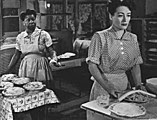 |
| Butterfly McQueen (1911-1995) & Joan Crawford in Mildred Pierce |
bills but did not challenge the mindset of executives avoiding financial consequences in the South. McQueen quit the movie business several times out of the frustration. of having to spend her film career playing maids, while industry executives continued to cast black actresses in demeaning roles that did not compete with white actresses. For many years, complexion, hair, facial features and body types were considered when casting female roles. Black actresses were cast as servants in the households of white families where their appearance was contrasted to that of the white female lead.
In the commercially successful 1945 movie, Mildred Pierce, with Joan Crawford, McQueen's uncredited role as the maid set a slightly new standard of human qualities for African Americans. This effort did not break up stereotypical casting. It took several more decades before the practice was abandoned.
 |
| Rosa Parks, E.B .Nixon, President Montgomery NAACP & Fred Gray, NAACP Attorney |
When McQueen appeared in the movie, Rosa Parks had been secretary for the Montgomery NAACP since 1943. People had become tired of seeing movies by Willie Best and others who seemed to downgrade the race.
Hollywood studio executives knew that scenes with black actors would be unmercifully cut out of their movies if the black actor was shown too respectfully or appeared in a scene on equal ground with a white actor. In most cases, the movie that was deemed unsuitably cast was not leased for showing in southern theaters, losing the studio money. The tactic of casting black female actresses as maids, cooks, nannies and caretakers of white families and their children also affected the roles that nearly white, black actresses could get.
Unlike Ethel Waters, Lena Horne refused to play servants, stipulated in her contract, causing a rift between Horne and Waters, who knew her paycheck depended on servants' roles and resented Horne for thinking she was too good to play a maid and perhaps too glamorous to be treated like black performers. The rift between the two deepened as Waters felt threatened by Horne's presence.
According to Horne's biography, Stormy Weather, the life of Lena Horne, by James Gavin, "Horne had forgotten an older pioneer, Ethel Waters, who had watched in pain as Horne came along and grabbed the spotlight." Black Hollywood was in transition as younger performers came onto the scene, many with elevated expectations, leaving older actors feeling betrayed, forgotten and left behind.
Like the changing of the guard, younger actors entered the ranks and performers like Ethel Waters and her contemporaries became part of yesterday's Hollywood. The youngsters broke all the old rules, like dating and marrying out of their races, trying to move into white only Hollywood neighborhoods, changing the types of roles they would play and getting racial equality on screen and off. All of these, mostly unsuccessful attempts at the time to break into mainstream acceptance, frightened the old timers. Born the year that Plessy v. Ferguson was decided, Ethel Waters only knew segregation and had no reason to think it would ever change. So, she simply accepted the servants' roles and whatever treatment Hollywood dished out to its black talent.
Black Americans like Rosa Parks--four years older than Lena Horne and of a similar racial heritage--prepared for social change differently through organized actions to benefit larger goals than satisfying personal or financial desire.
The year Lena Horne married white orchestra leader, Lennie Hayton, the first Freedom Riders took buses through the South. This followed the 1946 U.S. Supreme Court ruling that it was unconstitutional for black passengers to be forced to sit in the backs of buses traveling from state to state, while white passengers sat in front. To test the new ruling, a group of black and white passengers boarded buses in 1947 for the Journey of Reconciliation but were arrested in North Carolina and could not complete the journey.
In spite of social and political changes, executives knew movie distribution to Jim Crow theaters would be interrupted if the Southern image of how black persons should be portrayed on screen was not upheld. No mixing of the races or equality in relationships would be tolerated in the South. Two of Lena Horne's biggest complaints with her contract with M-G-M Studios was that the studio would not give her real acting roles with white actors and her romances with white men had to be cloaked in secrecy.
 |
| Buy Cabin in the Sky (1943) DVD Ethel Waters, Eddie "Rochester" Anderson & Lena Horne |
According to Horne's biography, Stormy Weather, the life of Lena Horne, by James Gavin, "Horne had forgotten an older pioneer, Ethel Waters, who had watched in pain as Horne came along and grabbed the spotlight." Black Hollywood was in transition as younger performers came onto the scene, many with elevated expectations, leaving older actors feeling betrayed, forgotten and left behind.
 |
| Lena Horne & Lennie Hayton Married in 1947 |
Like the changing of the guard, younger actors entered the ranks and performers like Ethel Waters and her contemporaries became part of yesterday's Hollywood. The youngsters broke all the old rules, like dating and marrying out of their races, trying to move into white only Hollywood neighborhoods, changing the types of roles they would play and getting racial equality on screen and off. All of these, mostly unsuccessful attempts at the time to break into mainstream acceptance, frightened the old timers. Born the year that Plessy v. Ferguson was decided, Ethel Waters only knew segregation and had no reason to think it would ever change. So, she simply accepted the servants' roles and whatever treatment Hollywood dished out to its black talent.
 |
| Rosa Parks Booking Photo Montgomery Bus Boycott December 1, 1955 |
The year Lena Horne married white orchestra leader, Lennie Hayton, the first Freedom Riders took buses through the South. This followed the 1946 U.S. Supreme Court ruling that it was unconstitutional for black passengers to be forced to sit in the backs of buses traveling from state to state, while white passengers sat in front. To test the new ruling, a group of black and white passengers boarded buses in 1947 for the Journey of Reconciliation but were arrested in North Carolina and could not complete the journey.
In spite of social and political changes, executives knew movie distribution to Jim Crow theaters would be interrupted if the Southern image of how black persons should be portrayed on screen was not upheld. No mixing of the races or equality in relationships would be tolerated in the South. Two of Lena Horne's biggest complaints with her contract with M-G-M Studios was that the studio would not give her real acting roles with white actors and her romances with white men had to be cloaked in secrecy.
Race relations in Hollywood was an issue that was closely tied to the Cold War in the 1940s and 1950s. During that period, the U.S. Government studied the situation through its various agencies: FBI, CIA and the .House of Un-American Activities Committee (HUAC), which carried out, among other things, investigations of the Hollywood film industry executives, writers, actors and other performers and talent to determine their connections with communism.
 |
| Lena Horne (1917-2010) |
Lena Horne was the first black star with an M-G-M (1942) Studio contract. Even though Horne was referred to by some as a white black woman because of her look and sound, hardly any of her scenes survived southern theater operators and the studios found it difficult to cast her, except as a singer who interacted with no other actors on film, except black ones. Movie executives were baffled as to what to do with Lena Horne as a studio commodity who had a more mainstream than African American appearance, although there was no mistaking that she was a black woman and had to be treated as such.
Further, light-skinned black actresses like Lena Horne could not be cast in movies, such as the 1951 Show Boat, even if roles called for a bi-racial appearance because white and black actors did not share scenes as equals in early Hollywood. Interaction between characters of different races was prohibited. Therefore, mulatto Julie in Show Boat could not have been played by a black actress. Bi-racial characters went to white actresses to prevent the interaction of whites and blacks. Mixed-race couples were not permitted on screen or off by Hollywood studios, a policy mirrored in American society.
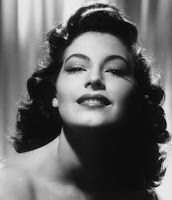 |
| Ava Gardner (1922-1990) |
 |
| Libby Holman (1904-1971) |
 |
| Ava Gardner, Stevie Wonder & Lena Horne (1984) |
Discouraged, Horne returned to New York where she felt more at home. Continuing to perform concerts worldwide, Horne complained of racist treatment she received in many areas of the nation, including the Deep South, the West and the Northeast. Horne's light complexion did not insulate her from discrimination.
About Stormy Weather, the life of Lena Horne by James Gavin from Publishers Weekly: ...much of Horne's perpetual frustration stemmed from the racism black entertainers faced in the pre–civil rights era. MGM glamorized her as a darker version of its white starlets, but gave her small roles and singing cameos that Southern theaters could conveniently excise. © Reed Business
 |
| Jeane Crain & Ethel Waters (1949) Purchase Pinky DVD |
Without offending racist attitudes, many black actors made the best of the demeaning roles they were forced to play and managed to make good money doing so. In the movie Pinky, white actress, Jeane Crain, plays the mixed-race granddaughter of the character played by Ethel Waters. In this movie, both casting practices are illustrated--bi-racial roles going to white actresses and black actresses are cast as servants.
We must remember, had it not been for the perseverance of these courageous black actors and actresses, we would not have the modern Hollywood of today that is much more inclusive than the Hollywood of the 1930s, 1940s, 950s and 1960s. Actress-singer, Dorothy Dandridge, who made her film debut in the 1950s, was the first black actress to be nominated for an Academy Award for Best Actress Award for her 1954 role as Carmen Jones.,one year before Rosa Parks made her protest in the Montgomery Bus Boycott. In 1999,
Academy Award winning actress, Halle Berry, played Dorothy Dandridge in the movie for television, Introducing Dorothy Dandridge. Capturing the appearance of the late star, Berry portrays the life of Dandridge during the dark days of pre-civil rights America when Dandridge was in an interracial marriage trying to survive in segregated Hollywood.
Academy Award winning actress, Halle Berry, played Dorothy Dandridge in the movie for television, Introducing Dorothy Dandridge. Capturing the appearance of the late star, Berry portrays the life of Dandridge during the dark days of pre-civil rights America when Dandridge was in an interracial marriage trying to survive in segregated Hollywood.
 |
| Buy DVD Introducing Dorothy Dandridge |
Amazon Review by Sean Axmaker..."but the electrifying stage chanteuse and dancer was forbidden to even enter the nightclubs and show rooms she performed in except from the stage. As portrayed by Halle Berry (right), who shepherded Dandridge's story to the screen, Dandridge is a sure, insistent star who battled racist studios and Jim Crow laws to maintain her dignity in public while stumbling through a private life marked by bad relationships and abusive lovers. Berry gives her best performance to date."
Rosa Parks and the Montgomery Bus Boycott directly crossed paths with Hollywood in 2002 when Angela Bassett co-produced and starred in a TV movie about Rosa Parks. Visit Rosa Parks and Jim Crow Laws in Black Hollywood to read, see photographs of the real Rosa Parks, Angela Bassett as Rosa Parks and the movie trailer. Also read and view photos at: Rosa Parks, Montgomery Bus Boycott & Jim Crow.
In the 1960s, Eartha Kitt, like Lena Horne ten years her senior, refused to play subservient roles in Hollywood films, on Broadway or on television. Considered by the industry as a crossover artist, Kitt's roles were mostly in movies with African American casts until 1967 when she was cast as Batman's Cat Woman, an appropriate choice since she was recognized as an American sex kitten, exhibited in her rendition of her 1953 Christmas hit, Santa Baby.
Even the race movies, however, wanted black actresses for their films with good looks, an air of superiority and light skin, believing these women set a high beauty standard for ordinary women to emulate and ordinary men to ogle. "I couldn't compromise on playing nigger parts," Kitt told Ebony's Richette Haywood, in spite of the rarity of truly dynamic roles available for black actresses in the mid-fifties.
Even the race movies, however, wanted black actresses for their films with good looks, an air of superiority and light skin, believing these women set a high beauty standard for ordinary women to emulate and ordinary men to ogle. "I couldn't compromise on playing nigger parts," Kitt told Ebony's Richette Haywood, in spite of the rarity of truly dynamic roles available for black actresses in the mid-fifties.
In 1946, Ruby appeared in her first movie, Love in Syncopation, and continued to star in film and television through the 1950s and 1960s. In many of her roles, she was a maid, but also played Rachel Robinson in the 1950 Jackie Robinson Story, worked in St. Louis Blues in 1958, starring Nat King Cole, featuring Cab Calloway, Eartha Kitt and Ella Fitzgerald. Dee debuted on TV in the 1960s in the soap opera, Guiding Light, and the series, Peyton Place (ABC, 1966-69) as the wife of an affluent black doctor.
Ruby Dee appeared in a film version of A Raisin in the Sun released by Columbia Pictures featuring the original Broadway cast, including Sidney Poitier and Ruby Dee, for which she won the National Board of Review Award for Best Supporting Actress.Nominated eight times for Emmy awards, she and won in 1991 for the TV movie, Decoration Day. In 2007, she was nominated for an Oscar and won a Screen Actor's Guild Award for her role in American Gangster, starring Denzel Washington.
Ruby Dee appeared in a film version of A Raisin in the Sun released by Columbia Pictures featuring the original Broadway cast, including Sidney Poitier and Ruby Dee, for which she won the National Board of Review Award for Best Supporting Actress.Nominated eight times for Emmy awards, she and won in 1991 for the TV movie, Decoration Day. In 2007, she was nominated for an Oscar and won a Screen Actor's Guild Award for her role in American Gangster, starring Denzel Washington.
Although it was Ruby Dee who broke into network television in the early 1960s, it was in 1968 that Diahann Carrol starred as Julia Baker, a widowed mother, in the television series, Julia. This was a real victory in the African American community. For the first time in television history, the star of the show was a black women who held a professional position and was not a wife or a maid. Julia was an independent, articulate and educated young mother taking care of her son in America. This was a giant step in race relations in America.
The nation sighed collectively. Some Americans were elated. Others were saddened. Regardless, the nation was finally ending its Civil War and entering a promising future that President Abraham Lincoln had made possible, but was not to witness. A few months after Julia debuted, the nation lost Dr. Martin Luther King, Jr., who had led the Montgomery Bus Boycott that was sparked by Rosa Parks. A few months after that, Robert F. Kennedy was also the target of an assassin's bullet. But the bell for equality had been rung and it would have been impossible to un-ring that historic bell.
Rosa Parks: A Biography (Greenwood Biographies)
Singer-actress, Ethel Waters, also limited to servants' roles, was the first black Hollywood superstar. She made her name and her fortune playing servants and had no problem with making her money that way. These were the only roles available to her and the roles that kept her working and making top dollar for a black actress.
According to Amazon Product Review, Ethel Waters is almost forgotten: "Although she was arguably the most influential female blues and jazz singer of the 1920s and 1930s, as well as a major black figure in 20th century theatre, cinema, radio and television, she is now the least remembered. In Ethel Waters: Stormy Weather, Stephen Bourne documents the career of this monumental figure in American popular culture, offering new insights into the work of this forgotten legend. Supplemented by fourteen photographs, this biography leaves little doubt as to why--for decades--no other black star was held in such high regard."
________________________________________________
 |
| Bigmama Didn't Shop At Woolworth's by Sunny Nash |
Sunny Nash is the author of Bigmama Didn't Shop at Woolworth's, a family memoir about life with her grandmother, Bigmama, before and during the Civil Rights Movement.
Nash has work in the African American National Biography by Harvard and Oxford; African American West, Century of Short Stories; Reflections in Black, History of Black Photographers 1840 - Present; Ancestry; Companion to Southern Literature; Texas Through Women’s Eyes; Black Genesis: A Resource Book for African-American Genealogy; African American Foodways; Southwestern American Literature Journal; The Source: guidebook to American genealogy; Bibliographic Guide to Black Studies; Interdisciplinary Journal for Germanic Linguistics; Ebony Magazine; Hidden Sources: Family History in Unlikely Places; and others.
Related Articles by Sunny Nash
Race Relations in America, the Woolworth’s Sit-ins
© 2011 Sunny Nash


Tweet
© 2011 Sunny Nash
All Rights Reserved Worldwide.
Terms for Use of Text & Images
When using text and images from the blog, please include Link.
www.sunnynash.blogspot.com
~Thank You~
Terms for Use of Text & Images
When using text and images from the blog, please include Link.
www.sunnynash.blogspot.com
~Thank You~
Tweet

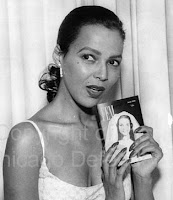




I'm reading Bigmamma Didn't Shop at Woolworth right now. A friend and I bought a copy two years ago at an independent bookstore in Philadelphia. It is an excellent read. I'm not done, but will return to your site once I finish.
ReplyDeleteThank you very much for reading my book. It is good to know that it reads well in all parts of the world. By the way, I think Philadelphia is a great city; it is part of a national photo study I am conducting. I hope you will return to my blog frequently and become a follower. I am grateful for you support. Sunny
DeleteI came across your writing from Ezine Articles and was interested in the black American Stars that have don a lot in terms of writing, film stars and entrepreneurs.
ReplyDeleteI also admire your creativity as a lady in this industry.
Continue the good work!
~ Charles
Thank you for your kind comments. I will keep articles on black entertainers, artists and celebrities on my list of topics to explore in the future. Thanks again. Sunny
Delete